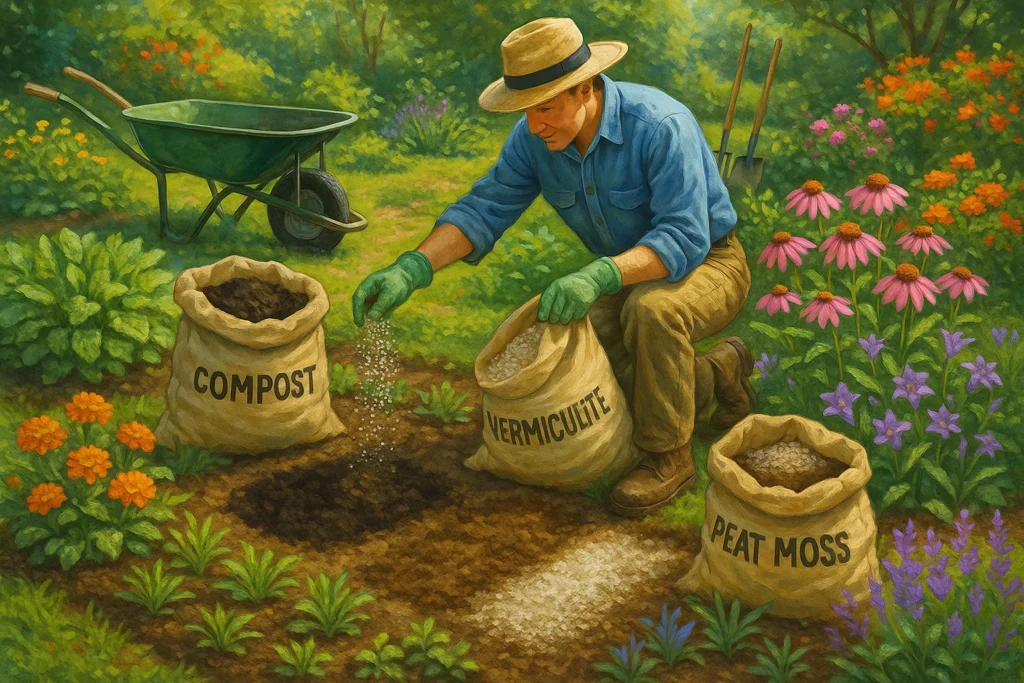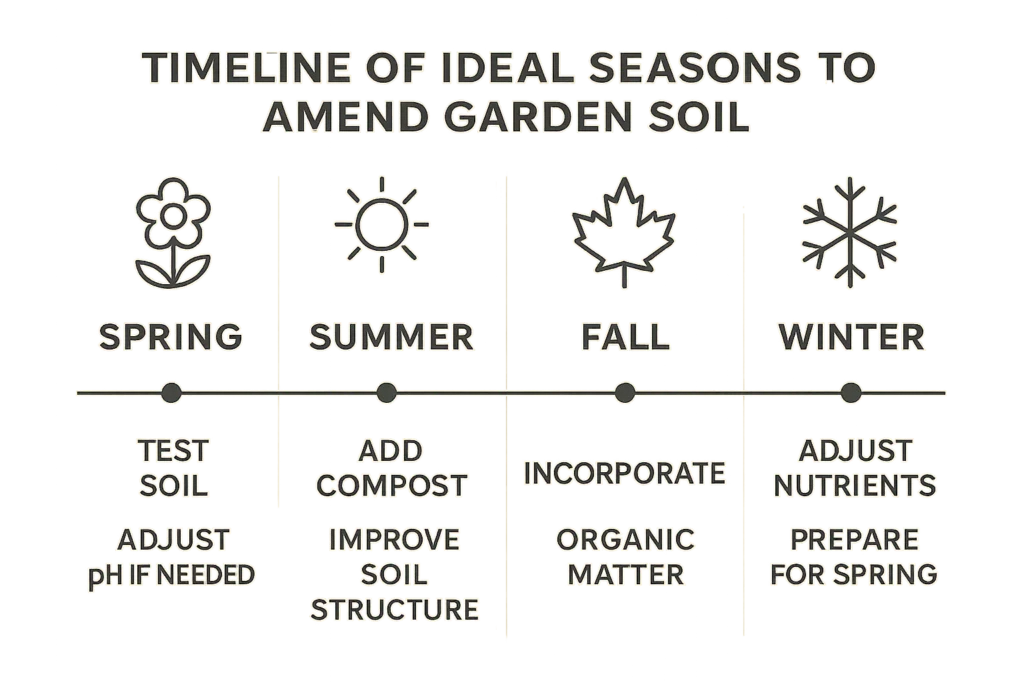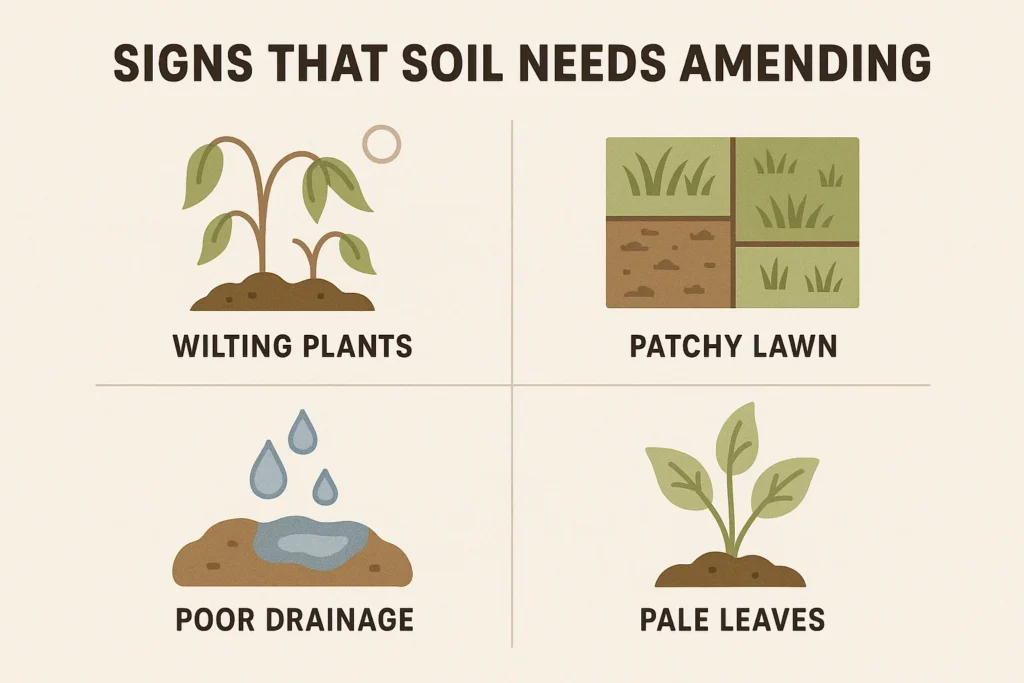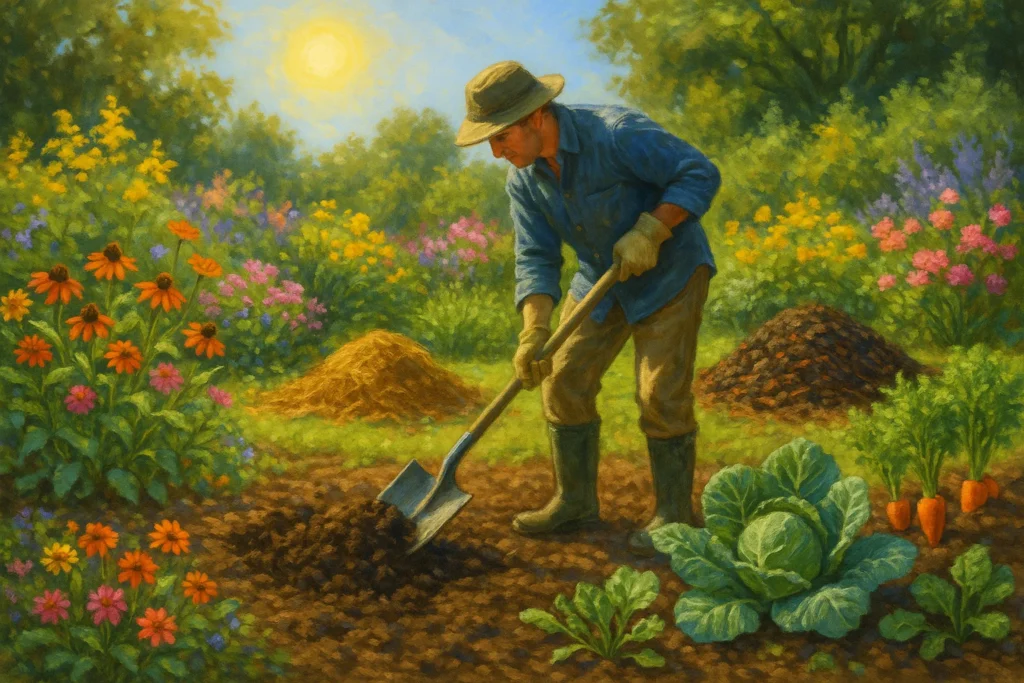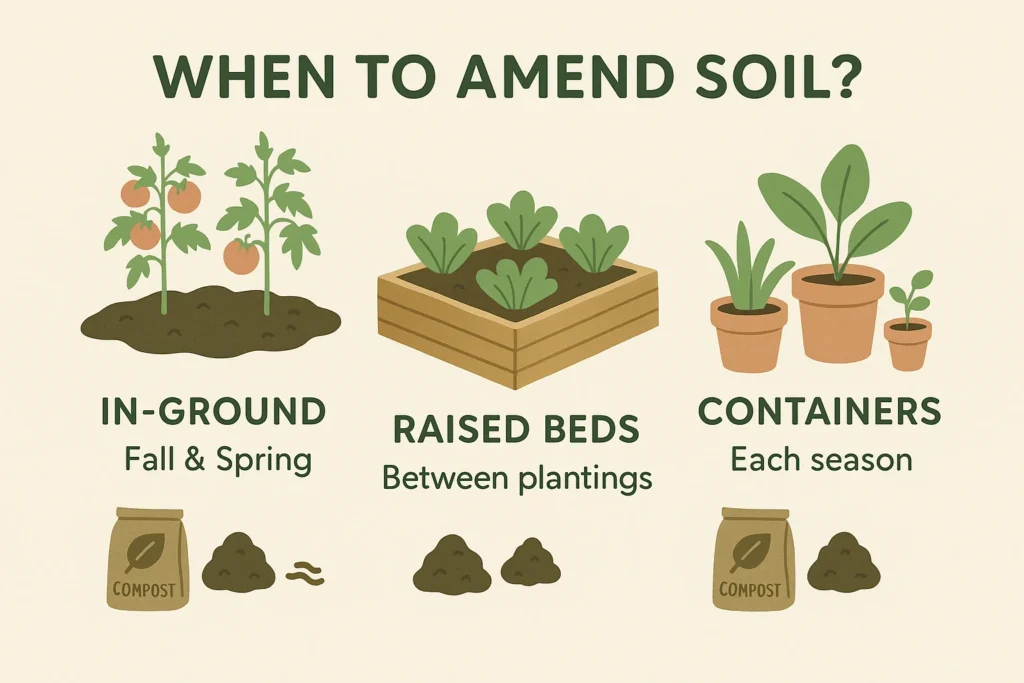When to Amend Soil: Essential Guide to Timing and Techniques
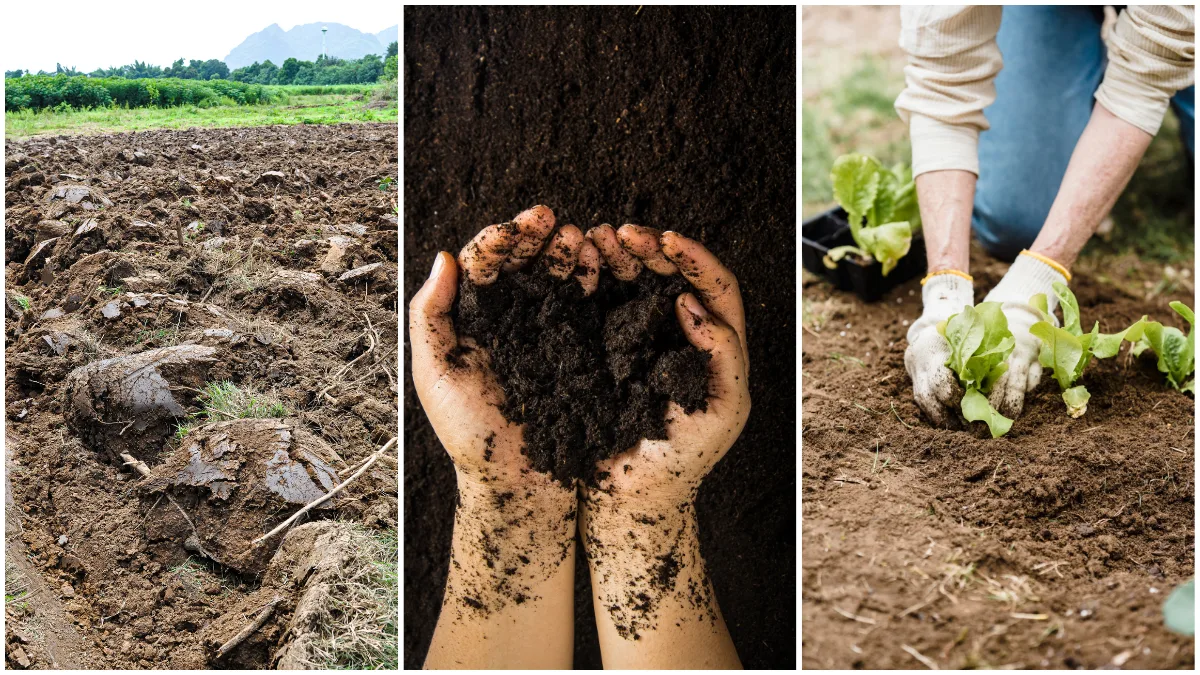
The best time to amend soil is typically in the fall, allowing organic materials to decompose over winter, enriching your garden for spring growth. However, spring applications can also prove beneficial if you missed the fall window. This comprehensive guide walks you through the ins and outs of when to amend soil, signs that indicate your soil needs a boost, and the best practices to ensure your garden flourishes.
We’ll begin by exploring what soil amendments are and their impact on garden health. You’ll learn the ideal times to introduce these amendments and recognize the telltale signs that your soil might need some help. Lastly, we’ll delve into various amendment types and how to apply them for optimal results.
Understanding Soil Amendments
Soil amendments are materials added to soil to improve its physical properties, such as permeability, water retention, and structure, making them crucial for a healthy garden. Unlike fertilizers, which primarily supply nutrients, amendments enhance the soil’s overall health and viability.
Types of common soil amendments include:
- Compost: Made from decomposed organic materials, it enhances soil structure, improves aeration, and supplies nutrients.
- Manure: Provides nutrients and enhances soil structure but must be aged to prevent nitrogen burn.
- Leaf Mold: Made from decomposed leaves, excellent for increasing moisture retention and providing humus.
- Composted Straw: Adds organic matter, enhancing drainage and soil aeration.
These amendments can also alter soil pH, thereby influencing nutrient availability and microbial activity. For instance, lime can raise pH in acidic soils, while sulfur can lower pH in alkaline soils. When applied correctly, soil amendments significantly contribute to improved plant growth and productivity. Understanding when to amend soil is just as important as knowing what to add—it can make or break your season’s success.
To estimate how much amendment you’ll need, try our free Soil Calculator — it helps you plan your garden accurately based on area and depth.
When to Amend Garden Soil for Optimal Growth?
The best time to add soil amendments is generally in the fall, allowing organic materials ample time to break down over the colder months. During winter, microorganisms decompose organic matter, resulting in a rich, fertile base by spring planting. Moreover, fall also coincides with leaf drop, providing abundant materials for your compost.
Many beginner gardeners overlook when to amend soil, but timing impacts how well nutrients are absorbed and roots establish. Spring is a viable alternative if fall amendments are not possible. Spring additions, ideally finished several weeks before planting, can still boost soil quality. However, the organic matter may not fully break down before planting, requiring careful selection of finely textured amendments like compost or well-rotted manure.
Seasonal changes directly impact the breakdown rate of organic materials. Colder, wet weather encourages slow decomposition, whereas summer heat accelerates it. As a gardener, taking these seasonal nuances into account helps ensure that when you amend garden soil, you maximize nutrient availability just as your plants need it.
To prepare soil for planting, consider conducting a simple soil test before applying amendments. This directs what particular amendments might be necessary, helping balance pH and nutrient composition effectively.
To estimate how much amendment you’ll need, try our free Soil Calculator — it helps you plan your garden accurately based on area and depth.
Signs Your Soil Needs Amending
Soil in need of amendment often shows noticeable signs, including:
- Poor Water Retention: Soil that consistently dries out quickly might lack organic matter.
- Rapid Water Drainage: Conversely, if water pools and drains too slowly, compaction could be your culprit.
- Compacted Soil: Tough, hard soil resists root growth and air penetration.
- Nutrient Deficiencies: Plants may exhibit stunted growth, yellowing leaves, or poor production despite fertilizer application.
Testing your soil gives clarity on these issues. Simple drainage tests can reveal how well your soil absorbs water, while texture tests involve moistening a soil sample to judge its workability. Addressing these indicators can lead to a dramatic improvement, resulting in robust growth and better yields from your garden beds.
Your climate and plant type determine when to amend soil—getting it right ensures a healthy start and sustained growth.
Best Practices for Amending Soil
Effectively integrating amendments requires careful attention to detail and timing. Follow this step-by-step guide for successful soil amendment:
- Plan Ahead: Perform a soil test to determine what amendments are necessary.
- Apply Amendments Evenly: Use a spreader for large areas or hand broadcast on smaller plots.
- Incorporate Amendments: Use a hoe or garden fork to lightly mix amendments into the top 6-8 inches, avoiding tilling if the soil is too wet or too dry as this can lead to compaction or erosion.
- Post-Amendment Care: Water thoroughly after amending to help begin the breakdown process.
After amending, monitor soil and plant responses. Adjust watering practices since amended soils often improve water retention. Ensure mulch layer application where suitable to protect against erosion and help maintain moisture.
Before adding anything, it’s wise to consider when to amend soil based on seasonal conditions and crop needs.
When Not to Amend Soil
While it’s common to improve your garden by adding organic matter, there are situations where amending soil can do more harm than good. Knowing when to amend soil also means knowing when to leave it alone.
Some experts, like those at Proven Winners, advise against amending soil when planting certain shrubs or trees. The reason? Amending just the planting hole can cause roots to circle within the soft, enriched soil instead of spreading into native soil. This leads to poor root establishment and instability.
Instead, for woody plants like shrubs and trees, plant directly in the native soil and top-dress with mulch. Reserve soil amendments for entire beds, vegetable plots, or annuals where full integration is possible.
Avoid amending soil:
- Only at planting holes for long-lived perennials or trees.
- In compacted areas if you can’t amend the entire root zone.
- During wet periods, where turning the soil can lead to compaction.
Knowing when not to amend soil ensures your interventions actually support long-term root health.
When to Amend Soil by Garden Type
The approach you take should also vary depending on your garden setup. Whether you’re gardening in the ground, containers, or raised beds, when to amend soil and how you do it differs:
| Garden Type | Amendment Strategy |
|---|---|
| In-Ground Beds | Amend soil in fall or spring. Work in compost or manure across the bed. |
| Containers | Refresh each season with compost, worm castings, or coco coir. |
| Raised Beds | Amend between growing cycles. Mix aged compost or a new blend of topsoil. |
Raised beds and containers often deplete nutrients faster and benefit from lighter, frequent amendments. For in-ground beds, a seasonal deep amendment in fall or early spring is typically sufficient.
Learning when to amend soil based on your garden type helps avoid overdoing it or applying amendments that don’t suit the setup.
Common Soil Amendments and Their Benefits
Exploring the range of soil amendments available, here’s a closer look at their benefits:
| Amendment | Benefits | Recommended Use |
|---|---|---|
| Compost | Improves structure, aeration, nutrients | All-purpose soil health |
| Aged Manure | Nutrient-rich, improves structure | Vegetable gardens, borders |
| Leaf Mold | Increases moisture retention | Mulch, soil conditioner |
| Composted Straw | Enhances aeration, organic matter | Improving heavy soils |
Choosing between soil amendment vs. compost depends on your garden’s specific needs. Compost is an excellent choice for overall improvement, while specific amendments like lime or sulfur are better for tailored pH adjustments. For a deeper scientific understanding of how various materials affect soil properties, explore this comprehensive soil amendment overview on ScienceDirect.
Before choosing an amendment, it’s a good idea to run a simple soil pH test or use our soil calculator to determine volume needs.
Frequently Asked Questions About When to Amend Soil
Q: What time of year should I amend soil?
A: Fall is the ideal time to amend soil, giving organic materials like compost or manure time to break down and improve soil structure by spring. Spring is also effective, especially for fast-growing crops.
Q: Is it better to amend soil in fall or spring?
A: Fall is generally better for amending soil due to the natural decomposition over winter, but spring amending works if fall was missed.
Q: How do I know if I need to amend my soil?
A: Signs like compacted soil, poor drainage, or yellowing leaves indicate when to amend soil. A simple water or texture test can confirm it.
Q: When should I avoid amending soil?
A: Don’t amend during wet or frozen conditions, or when planting trees and shrubs in native soil. Amending just the hole can hinder root expansion.
Q: How do I amend soil in raised beds or containers?
A: Refresh raised beds between crops and containers at each planting with compost or soil conditioners. Knowing when to amend soil in containers helps prevent nutrient loss.

